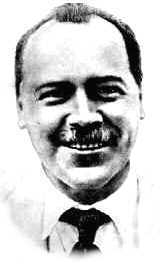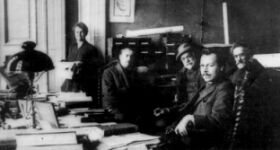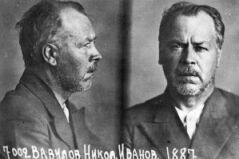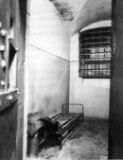Biography of Nikolai I. Vavilov  |
 |
 Nikolai I. Vavilov was born into the family of a
merchant in Moscow on November 25, 1887. In 1911, having graduated from
the Agricultural Institute, Vavilov continued to work at the Department
of Agriculture Proper headed by Prof. Pryanishnikov. In 1911-1912 Vavilov
did practical work at the Bureau for Applied Botany and at the Bureau of
Mycology and Phytopathology of the Agricultural Scientific Committee. In
1913-1914, Vavilov traveled to Europe where he studied plant immunity,
mostly with Prof. W. Bateson, a co-founder of the science of genetics.
Nikolai I. Vavilov was born into the family of a
merchant in Moscow on November 25, 1887. In 1911, having graduated from
the Agricultural Institute, Vavilov continued to work at the Department
of Agriculture Proper headed by Prof. Pryanishnikov. In 1911-1912 Vavilov
did practical work at the Bureau for Applied Botany and at the Bureau of
Mycology and Phytopathology of the Agricultural Scientific Committee. In
1913-1914, Vavilov traveled to Europe where he studied plant immunity,
mostly with Prof. W. Bateson, a co-founder of the science of genetics.
In autumn 1917 the Head of the Bureau for Applied Botany Robert. E. Regel (1867-1920) supported the nomination of N.I.Vavilov, a young professor from the Saratov Higher Agricultural Courses, as Deputy Head of the Bureau. As Regel wrote in his reference letter, "In the person of Vavilov we will employ ... a talented young scientist who would become the pride of national science". Regel's prediction turned out to be true. Since then, all Vavilov's life and creative work have been inseparable from the world's largest crop research institute, into which he transformed the Bureau in the 1920-30's.
Vavilov continued his investigations in Saratov where he has awarded the title of Professor of the Saratov University in 1918. During the Civil War, from 1918 to 1920, Saratov became the scientific stronghold for the Department of Applied Botany (Bureau till 1917). In 1920 Vavilov was elected head of the Department, and soon moved to Petrograd (St.Petersburg now) together with his students and associates.
In 1924, the Department was transformed into the Institute of Applied Botany and new Crops (VIR since 1930), and occupied the position of the central nationwide institution responsible for collecting the world plant diversity and studying it for the purposes of plant breeding.
 Vavilov is recognized as the foremost plant geographer
of contemporary times. To explore the major agricultural centers in this
country and abroad, Vavilov organized and took part in over 100 collecting
missions.
His major foreign expeditions included those to Iran (1916),
the United States, Central and South America (1921, 1930, 1932), the Mediterranean
and Ethiopia (1926-1927). For his expedition to Afghanistan in 1924 Vavilov
was awarded the N.M.Przhevalskii Gold Medal of the Russian Geographic Society.
From 1931 to 1940 Vavilov was its president.
Vavilov is recognized as the foremost plant geographer
of contemporary times. To explore the major agricultural centers in this
country and abroad, Vavilov organized and took part in over 100 collecting
missions.
His major foreign expeditions included those to Iran (1916),
the United States, Central and South America (1921, 1930, 1932), the Mediterranean
and Ethiopia (1926-1927). For his expedition to Afghanistan in 1924 Vavilov
was awarded the N.M.Przhevalskii Gold Medal of the Russian Geographic Society.
From 1931 to 1940 Vavilov was its president.
These missions and the determined search for plants were based on the Vavilov's concepts in the sphere of evolutionary genetics, i.e. the Law of Homologous Series in Variation (1920) and the theory of the Centers of Origin of Cultivated Plants (1926).
N.I.Vavilov was a prominent organizer of science. In the period from 1922 to 1929 he headed the Institute of Experimental Agronomy (the former ASC) which developed in 1930 into the V.I.Lenin All-Union Academy of Agriculture; from 1930 to 1935 Vavilov was its first president. From 1930 to 1940 he was director of the Institute of Genetics. Vavilov organized and participated in significant home and international scientific meetings and congresses on botany, genetics and plant breeding, agricultural economy, and the history of science. All around the world N.I.Vavilov has gained respect and renown; he was elected member of many academies of sciences and various foreign scientific societies.

 Vavilov, the symbol of glory of the national science,
is at the same time the symbol of its tragedy. As early as in the beginning
of the 1930's his scientific programs were being deprived of governmental
support. In the stifling atmosphere of a totalitarian state, the institute
headed by Vavilov turned into a resistance point to the pseudo-scientific
concepts of Trofim D.Lysenco. As a result of this controversy, Vavilov
was arrested in August 1940, and his closest associates were also sacked
and imprisoned.
Vavilov, the symbol of glory of the national science,
is at the same time the symbol of its tragedy. As early as in the beginning
of the 1930's his scientific programs were being deprived of governmental
support. In the stifling atmosphere of a totalitarian state, the institute
headed by Vavilov turned into a resistance point to the pseudo-scientific
concepts of Trofim D.Lysenco. As a result of this controversy, Vavilov
was arrested in August 1940, and his closest associates were also sacked
and imprisoned.
Vavilov's life ceased in the city where his star had once risen. He died in the Saratov prison of dystrophia on 26 January 1943 and was buried in a common prison grave.
Nevertheless, the memory of Vavilov has been preserved by his followers. During that tragic period they kept on gathering Vavilov's manuscripts, documents and pictures. Since mid-50's, after the official rehabilitation of Vavilov, hundreds of books and articles devoted to his life and scientific accomplishments have been published. Memorial displays have been opened in Moscow, St.Petersburg, Saratov and Poltava.
The name of Vavilov is born by the Russian Society of Geneticists and Breeders, the Institute of General Genetics of the Academy of Sciences, the Institute of Plant Industry, and the Saratov Agricultural Institute.
| Biography of Nikolai I. Vavilov |  |
| Major N.I.Vavilov's Expeditions |  |
| 1916 | Expedition to Iran (Hamadan and Khorasan) and Pamir (Shungan, Rushan and Khorog). |
| 1921 | Acquaintance trip to Canada (Ontario) and USA (New York, Pennsylvania, Maryland, Virginia, North and South Carolina, Kentucky, Indiana, Illinois, Iowa, Wisconsin, Minnesota, North and South Dakota, Wyoming, Colorado, Arizona, California, Oregon, Maine). |
| 1924 | Expedition to Afghanistan (Herat, Afghan Turkestan, Gaimag, Bamian, Hindu Kush, Badakhshan, Kafiristan, Jalalabad, Kabul, Herat, Kandahar, Baquia, Helmand, Farakh, Sehistan), accompanied by D.D. Bukinich and V.N. Lebedev. |
| 1925 | Expedition to Khoresm (Khiva, Novyi Urgench, Gurlen, Tashauz). |
| 1926-1927 | Expedition to Mediterranean countries (France, Syria, Palestine, Transjordan, Algeria, Morocco, Tunisia, Greece, Sicily, Sardinia, Cyprus and Crete, Italy, Spain, Portugal, and Egypt, where Gudzoni was explored by Vavilov's request) and to Abyssinia (Djibouti, Addis Ababa, banks of Nile, Tsana Lake), Eritrea (Massaua) and Yemen (Hodeida, Jidda, Hedjas). |
| 1927 | Exploration of mountainous regions in Wuertemberg (Bavaria, Germany). |
| 1929 | Expedition to China (Xinjiang - Kashgar, Uch-Turfan, Aksu, Kucha, Urumchi, Kulja, Yarkand, Hotan) together with M.G. Popov, then alone to Chine (Taiwan), Japan (Honshu, Kyushu and Hokkaido) and Korea. |
| 1930 | Expedition to USA (Florida, Louisiana, Arizona, Texas, California), Mexico, Guatemala and Honduras. |
| 1932-1933 | Trip to Canada (Ontario, Manitoba, Saskatchewan, Alberta, British Columbia), USA (Washington, Colorado, Montana, Kansas, Idaho, Louisiana, Arkansas, Arizona, California, Nebraska, Nevada, New Mexico, North and South Dakotas, Oklahoma, Oregon, Texas, Utah);
Expedition to Cuba, Mexico (Yucatan), Ecuador (Cordilleras), Peru (Lake Titicaca, Puno Mt., Cordilleras), Bolivia (Cordilleras), Chile (Panama River). Brazil (Rio de Janeiro, Amazon), Argentina, Uruguay, Trinidad and Porto Rico. |
| 1921-1940 | Systematic explorations of the European part of Russia and the whole regions of the Caucasus and the Middle Asia. |
| Major N.I.Vavilov's Expeditions |  |
| Major Collecting Missions Accomplished by N.I.Vavilov's Associates |  |
| 1922-1923 | Expedition of V.E.Pisarev and V.P.Kuzmin to Mongolia. |
| 1923 | Expedition of E.I.Barulina to Crimea (Ukraine). |
| 1924 | Expedition of E.I.Sinskaya to Altai. |
| 1925-1926 | Expedition of S.M.Bukasov and Yu.N.Voronov to Mexico, Guatemala and Colombia. |
| 1925-1926 | Expedition of E.N.Stoletova to Armenia. |
| 1925-1927 | Expedition of P.M.Zhukovsky to Turkey. |
| 1926 | Expedition of N.N.Kuleshov and V.V.Pashkevich to Azerbaijan. |
| 1926 | Expedition of K.A.Flyaksberger to Azerbaijan and Russia (Daghestan). |
| 1926 | Expedition of N.N.Kuleshov and V.K.Kobelev to Uzbekistan. |
| 1926 | Expedition of K.A.Flyaksberger to Far East of Russia. |
| 1926-1928 | Expedition of V.V.Markovich to Palestine, Pakistan, India, Java and Ceylon. |
| 1926-1928 | Expedition of S.V.Yuzepchuk to Peru, Bolivia and Chile. |
| 1927 | Expedition N.N.Kuleshov to Turkmenia. |
| 1927 | Expedition K.G.Kreier to Central and Western part of Siberia. |
| 1928-1929 | Expedition of E.N.Sinskaya to Japan. |
| 1928-1932 | Expedition of G.K.Kreier to Georgia and Azerbaijan. |
| 1930 | Expedition of E.A.Stoletova to Georgia (USSR). |
| 1930 | Expedition of G.K.Kreier to Kirgizia and Uzbekistan. |
| 1933 | Expedition of E.I.Barulina to Georgia (USSR). |
| Major Collecting Missions Accomplished by N.I.Vavilov's Associates |  |